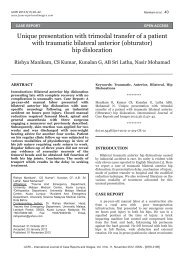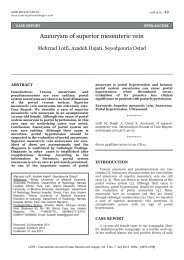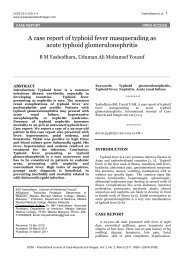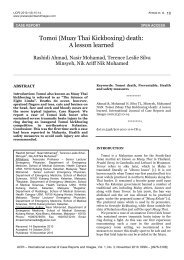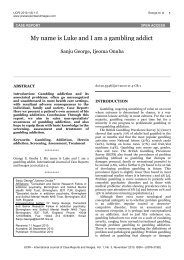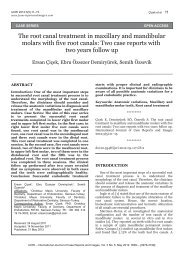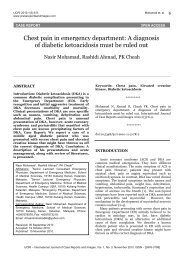Full Text PDF - International Journal of Case Reports and Images ...
Full Text PDF - International Journal of Case Reports and Images ...
Full Text PDF - International Journal of Case Reports and Images ...
You also want an ePaper? Increase the reach of your titles
YUMPU automatically turns print PDFs into web optimized ePapers that Google loves.
IJCRI 2011;2(5):1-6 . Doshi et. al. 1<br />
www.ijcasereports<strong>and</strong>images.com<br />
CASE SERIES<br />
OPEN ACCESS<br />
Multi drug resistant pseudomonas infection<br />
in open fractures post definitive fixation<br />
leading to limb loss: A report <strong>of</strong> three cases<br />
Hitendra K Doshi, Kenon Chua<br />
Fareed Kagda, Paul Ananth Tambyah<br />
ABSTRACT<br />
Introduction: Infection is a common<br />
complication in multiply traumatized patients<br />
with the majority being nosocomial in origin.<br />
We report a series <strong>of</strong> three patients with open<br />
fractures <strong>of</strong> lower limb which were initially<br />
debrided <strong>and</strong> stabilized with external fixation.<br />
Subsequent conversion to definitive internal<br />
fixation was performed. All three patients<br />
subsequently suffered limb loss as a result <strong>of</strong><br />
multiple drug resistant pseudomonas<br />
aeroginosa infection. <strong>Case</strong> report: We report<br />
three cases. <strong>Case</strong> 1 is a 48-year-old alcoholic<br />
male who sustained a Gustilo grade 3 (a) open<br />
fracture <strong>of</strong> the right tibia <strong>and</strong> Gustilo grade 1<br />
open fracture on the contralateral tibia. He<br />
underwent definitive fixation but subsequently<br />
developed a multiple drug resistant<br />
pseudomonas aeroginosa infection <strong>of</strong> the<br />
wound. Failure to eradicate the infection <strong>and</strong><br />
deteriorating s<strong>of</strong>t tissue conditions with<br />
Hitendra K Doshi 1 , Kenon Chua 2 , Fareed Kagda 3 , Paul<br />
Ananth Tambyah 4<br />
Affiliations: 1 Associate Consultant Surgeon, Department<br />
<strong>of</strong> Orthopaedics, National University Hospital <strong>of</strong><br />
Singapore, Singapore; 2 Medical Officer, Department <strong>of</strong><br />
Orthopaedics, National University Hospital <strong>of</strong> Singapore,<br />
Singapore;<br />
3 Senior Consultant, Department <strong>of</strong><br />
Orthopaedics, National University Hospital <strong>of</strong> Singapore,<br />
Singapore;<br />
4 Head <strong>of</strong> Infectious Disease Division,<br />
Department <strong>of</strong> Medicine, National University Hospital <strong>of</strong><br />
Singapore, Singapore.<br />
Corresponding Author: Dr. Kenon Chua, Blk 35, Chai<br />
Chee Avenue, #09-272; Singapore 461035; Singapore.<br />
Phone: 65-90080081; Email: flamenco@hotmail.com<br />
Received: 25 January 2011<br />
Accepted: 04 March 2011<br />
Published: 31 May 2011<br />
infected non-union lead to a final outcome <strong>of</strong><br />
below knee amputation <strong>and</strong> secondary stump<br />
closure. <strong>Case</strong> 2 is a 62-year-old male with no<br />
significant medical history who sustained a<br />
right grade 3 (a) supracondylar femur fracture<br />
<strong>and</strong> a left grade 3 (c) supracondylar femur<br />
fracture. He underwent definitive fixation after<br />
negative culture results but later developed<br />
multiple drug resistant pseudomonas<br />
aeroginosa wound infection. Failure to<br />
eradicate the infection, bony destruction <strong>and</strong><br />
deteriorating s<strong>of</strong>t tissue conditions led to a<br />
final outcome <strong>of</strong> removal <strong>of</strong> implant <strong>and</strong> above<br />
knee amputation post trauma. <strong>Case</strong> 3 is a 32-<br />
year-old female with no significant medical<br />
history who sustained a right gustilo 3 (a)<br />
supracondylar femur fracture. She later<br />
underwent definitive fixation after negative<br />
cultures. She subsequently had a multiple drug<br />
resistant pseudomonas aeroginosa wound<br />
infection. Failure to eradicate the infection <strong>and</strong><br />
deteriorating s<strong>of</strong>t tissue conditions with<br />
progressive destruction <strong>of</strong> bone led to a final<br />
outcome <strong>of</strong> above knee amputation.<br />
Conclusion: Multiple drug resistant<br />
pseudomonas wound infection is a very serious<br />
complication for patients with high energy<br />
open fractures; with a high likelihood <strong>of</strong> limb<br />
loss. Hospital measures to prevent the spread<br />
<strong>of</strong> nosocomial infection is critical for such<br />
patients.<br />
Keywords: Open fracture, Internal fixation,<br />
Drug resistant pseudomonas, Amputation<br />
*********<br />
Doshi HK, Chua K, Kagda F, Tambyah PA. Multi drug<br />
resistant pseudomonas infection in open fractures post<br />
definitive fixation leading to limb loss: A report <strong>of</strong><br />
three cases. <strong>International</strong> <strong>Journal</strong> <strong>of</strong> <strong>Case</strong> <strong>Reports</strong> <strong>and</strong><br />
<strong>Images</strong> 2011;2(5):1-6.<br />
*********<br />
IJCRI – <strong>International</strong> <strong>Journal</strong> <strong>of</strong> <strong>Case</strong> <strong>Reports</strong> <strong>and</strong> <strong>Images</strong>, Vol. 2, No. 5, May 2011. ISSN – [0976-3198]
IJCRI 2011;2(5):1-6 . Doshi et. al. 2<br />
www.ijcasereports<strong>and</strong>images.com<br />
doi:10.5348/ijcri-2011-05-31-CS-1<br />
INTRODUCTION<br />
Infectious complications <strong>of</strong> open fractures continue<br />
to pose a challenge to orthopedic surgeons <strong>and</strong><br />
patients. This is an increasing concern with multi-drug<br />
resistant nosocomial pathogens. Aggressive <strong>and</strong> timely<br />
repeated surgical debridement, negative pressure<br />
dressing <strong>and</strong> antibiotics (local <strong>and</strong> systemic) have led<br />
to a favorable outcome in many cases. However, the<br />
impact <strong>of</strong> emerging multi-drug resistant Pseudomonas<br />
aeruginosa (MDRPA) in musculo-skeletal injuries has<br />
not been described in surgical literature. We report a<br />
series <strong>of</strong> three open fractures, which were managed<br />
appropriately with wound debridement <strong>and</strong> external<br />
fixation followed by definitive internal fixation when<br />
wounds were sterile. Subsequent infection by MDRPA<br />
resulted in s<strong>of</strong>t tissue loss <strong>and</strong> bony destruction<br />
leading to amputation in all three cases.<br />
the patient was asymptomatic <strong>and</strong> as advised by the<br />
infectious disease team. The patient was discharged<br />
well at day 14, however subsequent early wound<br />
breakdown at day 30 required multiple debridements<br />
<strong>and</strong> vacuum assisted closure (VAC) dressings with<br />
intravenous vancomycin. Though the wound was<br />
granulating well initially, subsequent progressive<br />
wound breakdown resulted in exposure <strong>of</strong> implant <strong>and</strong><br />
non union <strong>of</strong> the fracture was evident (Figure 1). At<br />
this point in time cultures obtained<br />
aseptically were repeatedly positive for MDRPA<br />
susceptible only to polymyxin with no traces <strong>of</strong> MRSA.<br />
Failure to eradicate the infection <strong>and</strong> deteriorating s<strong>of</strong>t<br />
tissue conditions with infected non-union lead to a<br />
final outcome <strong>of</strong> below knee amputation <strong>and</strong> secondary<br />
stump closure. The stump healed well with no evidence<br />
<strong>of</strong> infection (Figure 2). There were no complications<br />
for the left tibia <strong>and</strong> patient was ambulating full weight<br />
bearing on the left limb three months after the surgery.<br />
CASE SERIES<br />
<strong>Case</strong> 1: A 48-year-old, chronic alcoholic male was<br />
involved in a road traffic accident <strong>and</strong> presented with a<br />
Gustilo grade 3 (a) open fracture <strong>of</strong> the right tibia <strong>and</strong><br />
Gustilo grade 1 open fracture on the contralateral tibia.<br />
The left tibia was fixed definitely with an<br />
intramedullary nail. Meanwhile, the right tibia<br />
required extensive wound debridement <strong>and</strong> an<br />
application <strong>of</strong> external fixator. Initial wound culture<br />
was positive for Enterobacter cloacae sensitive to<br />
imipenam <strong>and</strong> treated accordingly. Extensive skin loss<br />
over the fracture site required a local soleus muscle<br />
flap <strong>and</strong> skin grafting on day 21 post – trauma which<br />
healed satisfactorily though the wound remained<br />
colonized. The patient was discharged well with oral<br />
antibitics, but unfortunately defaulted follow up <strong>and</strong><br />
presented five months later with dislodged Shanz pins<br />
from the tibia <strong>and</strong> non-union <strong>of</strong> fracture.<br />
Removal <strong>of</strong> external fixator <strong>and</strong> debridement <strong>of</strong> pin<br />
sites was performed <strong>and</strong> the non- united tibia was<br />
stabilized with a cast. Initial superficial pin track<br />
cultures were positive for Methicillin-resistant<br />
Staphylococcus aureus (MRSA) sensitive only to<br />
vancomycin <strong>and</strong> fusidic acid, <strong>and</strong> were treated with<br />
topical mupirocin (Bactroban R) to the pin tracks with<br />
readmission plans one month later. The patient<br />
defaulted follow-up again <strong>and</strong> presented three months<br />
later with healed pin track wounds but with non-union<br />
<strong>of</strong> the tibia. Since inflammatory markers were normal<br />
<strong>and</strong> s<strong>of</strong>t tissue condition was favorable, the patient was<br />
subjected to plating <strong>of</strong> the tibia with autologous bone<br />
grafting though persistent colonization with MRSA was<br />
not ruled out at that point in time. Intra-operative<br />
cultures taken from the fracture at the time <strong>of</strong> surgery<br />
grew MRSA however it was not treated systemically as<br />
Figure 1: Intra-operative picture <strong>of</strong> fracture non-union <strong>of</strong><br />
<strong>Case</strong> 1.<br />
Figure 2: Picture <strong>of</strong> amputation stump wound <strong>of</strong> <strong>Case</strong> 1.<br />
IJCRI – <strong>International</strong> <strong>Journal</strong> <strong>of</strong> <strong>Case</strong> <strong>Reports</strong> <strong>and</strong> <strong>Images</strong>, Vol. 2, No. 5, May 2011. ISSN – [0976-3198]
IJCRI 2011;2(5):1-6 . Doshi et. al. 3<br />
www.ijcasereports<strong>and</strong>images.com<br />
<strong>Case</strong> 2: A 62-year-old male machine operator with<br />
unremarkable past medical history was run over by<br />
tractor. He sustained a right grade 3 (a) supracondylar<br />
femur fracture <strong>and</strong> a left grade 3 (c) supracondylar<br />
femur fracture. Both legs were debrided <strong>and</strong> stabilized<br />
with a bridging external fixator. The left lower limb<br />
had an associated vascular injury which required<br />
revascularization. After wound debridement was<br />
carried out <strong>and</strong> upon a negative culture result from the<br />
surgical site at debridement, both limbs were stabilised<br />
definitively with titanium locked plates.<br />
The left leg developed acute ischemic trauma post<br />
fixation due to graft thrombosis which was<br />
management urgently with a thrombectomy. The<br />
wounds healed well in the left leg however there was<br />
wound breakdown in the right limb which required<br />
multiple debridement <strong>and</strong> VAC dressings. A<br />
subsequent operative culture was positive for MDRPA<br />
<strong>and</strong> was started on polymyxin based on culture<br />
sensitivity. However, the patient went into acute renal<br />
failure <strong>and</strong> the polymyxin had to be withdrawn. The<br />
acute renal failure resolved thereafter. The patient<br />
underwent multiple debridement <strong>and</strong> VAC dressing<br />
with instillation <strong>of</strong> 2 % acetic acid. However the wound<br />
continued deteriorating (Figure 3) <strong>and</strong> finally<br />
developed positive cultures for MDRPA. Failure to<br />
eradicate the infection, bony destruction <strong>and</strong><br />
deteriorating s<strong>of</strong>t tissue conditions led to a final<br />
outcome <strong>of</strong> removal <strong>of</strong> implant <strong>and</strong> above knee<br />
amputation post trauma. The stump was closed<br />
secondarily <strong>and</strong> healed well with no evidence <strong>of</strong><br />
infection (Figure 4). Meanwhile the left femur had<br />
radiological evidence <strong>of</strong> healing with no s<strong>of</strong>t tissue<br />
issues <strong>and</strong> good vascularity after six months <strong>of</strong> followup.<br />
<strong>Case</strong> 3: A 32 year old female (motorcycle pilion<br />
rider) with unremarkable past medical history was<br />
involved in a road traffic accident. She sustained a<br />
right gustilo 3 (a) supracondylar femur fracture with a<br />
soil contamination <strong>of</strong> the wound. Extensive would<br />
debridement with a bridging external fixation was<br />
applied. The large open wound was treated with<br />
multiple wound debridments <strong>and</strong> VAC dressings. A<br />
definitive fixation with a titanium locked plate was<br />
performed with adequate s<strong>of</strong>t tissue cover after<br />
negative culture results.<br />
Subsequent wound breakdown was associated with<br />
Enterobacter cloacae infection requiring multiple<br />
wound debridement <strong>and</strong> VAC dressings together with<br />
systemic ceftriaxone. Cultures were subsequently<br />
positive for Pseudomonas <strong>and</strong> intravenous piperacillin<br />
was commenced based on sensitivity. The patient<br />
underwent multiple wound debridements with VAC<br />
dressings. However, the local wound never improved<br />
<strong>and</strong> the inflammatory markers remained persistently<br />
elevated. Therefore, a more radical approach was<br />
attempted. The titanium plate was removed <strong>and</strong><br />
fracture ends excised to healthy bone level. Reconversion<br />
to external fixation was performed at the<br />
Figure 3: Picture <strong>of</strong> infected wound <strong>of</strong> <strong>Case</strong> 2.<br />
Figure 4: Picture <strong>of</strong> healed amputation stump wound <strong>of</strong> <strong>Case</strong><br />
2.<br />
same setting with gentamicin impregnated cement<br />
spacer (Figure 5). Subsequent cultures grew MDRPA<br />
sensitive only to polymyxin, however the patient<br />
developed a serious cutaneous drug allergy <strong>and</strong><br />
polymixin was stopped. The patient underwent<br />
repeated debridement <strong>of</strong> s<strong>of</strong>t tissue <strong>and</strong> aggressive<br />
debridement <strong>of</strong> unhealthy bone followed by VAC<br />
dressings. Failure to eradicate the infection <strong>and</strong><br />
deteriorating s<strong>of</strong>t tissue conditions with progressive<br />
destruction <strong>of</strong> bone led to a final outcome <strong>of</strong> above<br />
knee amputation. The stump was closed secondarily<br />
<strong>and</strong> healed well with no evidence <strong>of</strong> infection after 4<br />
months <strong>of</strong> follow-up (Figure 6).<br />
DISCUSSION<br />
Infection is a common complication in multiply<br />
traumatized patients with the majority being<br />
nosocomial in origin which is related to various<br />
IJCRI – <strong>International</strong> <strong>Journal</strong> <strong>of</strong> <strong>Case</strong> <strong>Reports</strong> <strong>and</strong> <strong>Images</strong>, Vol. 2, No. 5, May 2011. ISSN – [0976-3198]
IJCRI 2011;2(5):1-6 . Doshi et. al. 4<br />
www.ijcasereports<strong>and</strong>images.com<br />
Figure 5: X-ray film <strong>of</strong> right lower limb with gentamicin<br />
impregnated cement spacer in-situ <strong>of</strong> <strong>Case</strong> 3.<br />
Figure 6: Picture <strong>of</strong> healed amputation stump wound <strong>of</strong> <strong>Case</strong><br />
3.<br />
procedures performed especially for the critically ill<br />
[1]. However, in musculoskeletal injuries, especially<br />
open fractures, the early bacterial contamination is <strong>of</strong><br />
greatest concern. This is particularly so for the cases<br />
being discussed as all were Gustilo grade 3 open<br />
fractures which are known to have a high rate <strong>of</strong><br />
infection. Therefore, timely <strong>and</strong> thorough wound<br />
debridement is <strong>of</strong> paramount importance. Besides<br />
surgical debridement, local dressings are important for<br />
wound coverage. Though conventional antibiotic<br />
dressings are commonly used for open wounds, VAC<br />
dressings have a promising outcome in large <strong>and</strong> deep<br />
wounds. It is a viable adjunct for the treatment <strong>of</strong> open<br />
high-energy injuries [2] <strong>and</strong> has been shown to result<br />
in earlier <strong>and</strong> more reliable primary closure [3]. All 3<br />
cases were thoroughly debrided with an application <strong>of</strong><br />
an external fixation <strong>and</strong> VAC dressing. They were given<br />
initial systemic broad spectrum antibiotics<br />
(cephalosporins <strong>and</strong> gentamicin). Subsequent<br />
modifications based on culture <strong>and</strong> sensitivity <strong>of</strong><br />
microorganisms from specimens obtained at surgical<br />
debridement was co-managed by the infectious disease<br />
team as per protocol.<br />
The goal in managing open fractures is to achieve a<br />
sterile wound early to accommodate a stable internal<br />
fixation as a definitive treatment. Clinical judgment is<br />
necessary with particular attention to s<strong>of</strong>t tissue<br />
conditions <strong>and</strong> ensuring a sterile base with repeated<br />
debridement. Due to the nature <strong>of</strong> injury requiring<br />
prolonged hospital stay, there is a significant risk <strong>of</strong><br />
developing secondary nosocomial infection or<br />
colonization that can alter the final outcome. Based<br />
on previously published reports [4], the initial<br />
organisms may be polymicrobial (both gram positive<br />
<strong>and</strong> negative), however the gram negative isolates from<br />
initial wound culture are not recovered again at the<br />
time <strong>of</strong> second operation in contrast to persistence <strong>of</strong><br />
gram positive isolates. In our patients, isolates from<br />
initial cultures were successfully eradicated but<br />
subsequent positive cultures were nosocomial in origin<br />
being highly drug resistant. Administration <strong>of</strong> broad<br />
spectrum antibiotics <strong>and</strong> multiple wound<br />
debridements with VAC dressing did create a sterile<br />
wound initially for internal fixation for two cases, but<br />
unfortunately this did not remain so perhaps due to<br />
cross contamination.<br />
Definitive fixation was performed using a titanium<br />
plate with a healthy s<strong>of</strong>t tissue cover. Though the use <strong>of</strong><br />
titanium implants reduces the risk <strong>of</strong> infection as<br />
compared to conventional stainless steel plate [5],<br />
multiplication <strong>of</strong> bacteria on the surface <strong>of</strong> implants in<br />
a bi<strong>of</strong>ilm poses a risk <strong>of</strong> infection when considering<br />
definitive treatment. In vitro studies have shown that a<br />
synergistic combination <strong>of</strong> antibiotics reduces the<br />
occurrence <strong>of</strong> resistant strains [6] though this has not<br />
been shown in orthopaedic clinical practice. There<br />
were no major intra-operative complications; however,<br />
there was wound breakdown in all the three cases<br />
within two weeks post-fixation. Cultures taken from all<br />
three patients after wound breakdown demonstrated<br />
the presence <strong>of</strong> MDRPA infection. Interestingly, apart<br />
from the first patient who was a constant defaulter,<br />
none <strong>of</strong> the other patients had gram-positive<br />
organisms isolated from late operative cultures post<br />
implantation.<br />
The emergence <strong>of</strong> multi-drug resistance is<br />
multifactorial. Wound culture studies in open<br />
musculo-skeletal injuries has reported gram negative<br />
isolates to be as high as 40% with pseudomonas<br />
aeruginosa being close to 11% [7]. Although 80% <strong>of</strong><br />
IJCRI – <strong>International</strong> <strong>Journal</strong> <strong>of</strong> <strong>Case</strong> <strong>Reports</strong> <strong>and</strong> <strong>Images</strong>, Vol. 2, No. 5, May 2011. ISSN – [0976-3198]
IJCRI 2011;2(5):1-6 . Doshi et. al. 5<br />
www.ijcasereports<strong>and</strong>images.com<br />
pseudomonas isolates are sensitive to gentamicin [8],<br />
the emergence <strong>of</strong> multi resistance poses a significant<br />
problem <strong>of</strong> eradication. This is particularly so in East<br />
Asia including Singapore [9]. The interplay <strong>of</strong><br />
persistence, transfer <strong>of</strong> resistance elements, <strong>and</strong> cell –<br />
cell interaction contribute to difficulty in treating<br />
multidrug – resistant strains [10]. All three patients<br />
had deteriorating s<strong>of</strong>t tissue infection failing repeated<br />
debridement <strong>and</strong> VAC dressings. Non -union <strong>of</strong> the<br />
fracture site also suggest sub-clinical osteomyelitis as<br />
there were radiological features <strong>of</strong> osteomyelitis.<br />
Nevertheless, X-ray might be less sensitive for<br />
detection <strong>of</strong> osteomyelitis due to Pseudomonas<br />
infection, hence leading to delayed detection<br />
radiologically. This is consistent with an experimental<br />
model <strong>of</strong> osteomyelitis which showed decreased<br />
severity <strong>of</strong> infection as demonstrated by X ray, <strong>and</strong> less<br />
evidence <strong>of</strong> sequestrum formation with P. aeruginosa<br />
when compared with Staphylococcus [11]. Though<br />
there was no clinical evidence <strong>of</strong> systemic sepsis, with<br />
negative blood cultures <strong>and</strong> the downward trend <strong>of</strong><br />
inflammatory markers, all three patients<br />
eventually had to have amputations due to the local<br />
effects <strong>of</strong> infection. This is consistent with a similar<br />
case series <strong>of</strong> pseudomonas infection <strong>of</strong> sternum <strong>and</strong><br />
costal cartilage which eventually required extensive<br />
excision for complete healing [12].<br />
In case 1, both legs were injured however the right<br />
limb with grade 3(a) injury succumbed compared to<br />
the grade 1 injury on the contralateral limb. In case 2,<br />
the right limb with grade 3(a) injury succumbed<br />
however the contralateral limb with greater severity<br />
<strong>and</strong> initial vascular compromise healed satisfactorily.<br />
The patient in case 1 is a Cierny type C host who<br />
defaulted follow-up, however, the final outcome<br />
showed only local compromise requiring amputation<br />
with no systemic complications. Meanwhile, when<br />
compared with the management <strong>of</strong> case 2, the more<br />
radical approach in case 3 with timely removal <strong>of</strong><br />
implant <strong>and</strong> excision <strong>of</strong> bone led to similar outcomes<br />
although they were both at a lower risk <strong>of</strong> infection as<br />
Cierny type A host. These findings suggest that local<br />
host factors after severe trauma <strong>and</strong> the presence <strong>of</strong> an<br />
implant may be less important factors for wound<br />
breakdown. Instead, the prolonged hospital stay due to<br />
the nature <strong>of</strong> injury might predispose to colonization<br />
with multi-resistant organisms. However, all the three<br />
patients in our series presented at different occasions<br />
with no particular cluster <strong>of</strong> MDRPA present in the<br />
wards during the time <strong>of</strong> treatment respectively.<br />
Though this reduces the possibility <strong>of</strong> cross infections<br />
in all three cases, a larger comparative study would be<br />
required to show this definitively.<br />
We conclude that MDRPA infection can cause<br />
significant patient morbidity in otherwise healthy<br />
young individuals in association with high energy<br />
injuries. Though, the host may not be immunocompromised<br />
systemically or locally, the local s<strong>of</strong>t<br />
tissue <strong>and</strong> bony milieu in grade 3 injuries favour rapid<br />
colonization <strong>of</strong> these resistant opportunistic<br />
organisms. After colonization, these organisms cause<br />
progressive s<strong>of</strong>t tissue loss <strong>and</strong> sub-clinical infected<br />
non-union eventually requiring limb amputation for<br />
complete eradication. It must be emphasized that the<br />
extreme difficulty to eradicate the infection despite<br />
multiple s<strong>of</strong>t tissue <strong>and</strong> bony debridements<br />
demonstrates the unique ‘surgical resistance’ <strong>of</strong> drug<br />
resistant pseudomonas.<br />
Measures to prevent the spread <strong>of</strong> nosocomial<br />
infection should be taken in all patients, but especially<br />
so in patients with high energy fractures undergoing<br />
definitive fixation. This includes meticulous training <strong>of</strong><br />
all health care staff to comply with judicious h<strong>and</strong><br />
washing between individual patient contact as well as<br />
avoiding formites. Patients should be warded in<br />
relative isolation from infected cases, given the limits<br />
<strong>of</strong> the hospital resources. In fact, post-operative<br />
patients may benefit from being discharged to a<br />
dedicated rehabilitation hospital where there may be<br />
less risk <strong>of</strong> infection. VAC dressings can provide an<br />
impermeable barrier between the wound <strong>and</strong> the<br />
external environment to limit the spread <strong>of</strong> infection.<br />
It is an advantage to have a dedicated orthopedic<br />
trauma surgeon, who has experience managing<br />
complicated open fractures. Vigilance post operatively<br />
for subsequent infection, as well as awareness that P.<br />
aeruginosa osteomyelitis may not be so evident<br />
radiologically is important.<br />
In the presence <strong>of</strong> infection, timely <strong>and</strong> adequate<br />
surgical debridement with removal <strong>of</strong> bone graft <strong>and</strong><br />
implants should be done. Regular, objective<br />
assessment should be done to determine if the<br />
infection is improving. Finally however, if all measures<br />
have failed to eradicate the infection; an amputation<br />
<strong>and</strong> early patient mobilization may be the best option<br />
to save the patient’s life. Prolonged <strong>and</strong> indefinite<br />
hospital stay to undergo nephrotoxic antibiotic<br />
treatment should not be recommended, once it is<br />
established that the infection is not improving.<br />
CONCLUSION<br />
Multi-resistant pseudomonas infected open<br />
fractures have a poor prognosis. It is very difficult to<br />
eradicate the infection once it has been established.<br />
Definite measures should be taken in patients with<br />
high impact open fractures to prevent the spread <strong>of</strong><br />
nosocomial infections. Timely amputation may be the<br />
only way to save these patients’ lives if the infection<br />
fails to improve.<br />
*********<br />
Author Contributions<br />
Hitendra Doshi - Substantial contributions to<br />
conception <strong>and</strong> design, Acquisition <strong>of</strong> data, Drafting<br />
the article, Revising it critically for important<br />
intellectual content, final approval <strong>of</strong> the version to be<br />
published<br />
IJCRI – <strong>International</strong> <strong>Journal</strong> <strong>of</strong> <strong>Case</strong> <strong>Reports</strong> <strong>and</strong> <strong>Images</strong>, Vol. 2, No. 5, May 2011. ISSN – [0976-3198]
IJCRI 2011;2(5):1-6 . Doshi et. al. 6<br />
www.ijcasereports<strong>and</strong>images.com<br />
Kenon Chua - Substantial contributions to conception<br />
<strong>and</strong> design, Acquisition <strong>of</strong> data, Drafting the article,<br />
Revising it critically for important intellectual content,<br />
Final approval <strong>of</strong> the version to be published<br />
Fareed Kagda - Substantial contributions to conception<br />
<strong>and</strong> design, Acquisition <strong>of</strong> data, Drafting the article,<br />
Revising it critically for important intellectual content,<br />
Final approval <strong>of</strong> the version to be published<br />
Paul Ananth Thambyah - Substantial contributions to<br />
conception <strong>and</strong> design, Acquisition <strong>of</strong> data, Drafting<br />
the article, Revising it critically for important<br />
intellectual content, Final approval <strong>of</strong> the version to be<br />
published<br />
Guarantor<br />
The corresponding author is the guarantor <strong>of</strong><br />
submission.<br />
Bacterial Isolates from Septic Post Operative<br />
Wounds in a Regional Referral Hospital in Ug<strong>and</strong>a .<br />
Afr Health Sci, 2007;7(3):148-154.<br />
9. Hsu LY, Tan TY, Jureen R, Koh TH, Krishnan P,<br />
Tzer-Pin Lin R, Wen-Sin Tee N, Tambyah PA.<br />
Antimicrobial drug resistance in Singapore<br />
hospitals. Emerg Infect Dis 2007;13(12):1944-1947.<br />
10. Navon Venezia S. Ben- Ami R, Carmelia Y. Update<br />
on Pseudomonas Aeuruginosa <strong>and</strong> Acinetobacter<br />
Baumannii infections in the Healthcare Setting.<br />
Curr Opin Infec Dis 2005:18(4):306-313.<br />
11. Norden CW, Keleti E. Experimental Osteomyelitis<br />
Caused by Pseudomonas.Aeruginosa. J Infect Dis<br />
1980;141(1):71-75.<br />
12. Miller DR , Murphy K, Cesario T. Pseudomonas<br />
Infection <strong>of</strong> the Sternum <strong>and</strong> Costal Cartilages.<br />
Report <strong>of</strong> Three <strong>Case</strong>s. J Thorac Cardiovasc Surg<br />
1978;76(5):723-8.<br />
Conflict <strong>of</strong> Interest<br />
Authors declare no conflict <strong>of</strong> interest.<br />
Copyright<br />
© Hitendra K Doshi et. al. 2011; This article is<br />
distributed under the terms <strong>of</strong> Creative Commons<br />
attribution 3.0 License which permits unrestricted use,<br />
distribution <strong>and</strong> reproduction in any means provided<br />
the original authors <strong>and</strong> original publisher are properly<br />
credited. (Please see www.ijcasereports<strong>and</strong>images.com<br />
/copyright-policy.php for more information.)<br />
REFERENCES<br />
1. Caplan ES, Hoyt NJ . Identification <strong>and</strong> Treatment<br />
<strong>of</strong> Infections in Multiply Traumatized Patients. Am<br />
J Med 1985;79(1A):68-76.<br />
2. Herscovici D Jr, S<strong>and</strong>ers RW, Scaduto JM, Infante<br />
A, DiPasquale T. Vacuum Assisted Wound Closure<br />
for the Management <strong>of</strong> Patients with High-Energy<br />
S<strong>of</strong>t Tissue Injuries. J Orthop Trauma<br />
2003;17(10):683-688.<br />
3. Leininger BE, Rasmussen TE, Smith DL, Jenkins<br />
DH, Coppola C. Experience with Wound VAC <strong>and</strong><br />
Delayed Primary Closure <strong>of</strong> Contaminated S<strong>of</strong>t<br />
Tissues injuries in Iraq. J Trauma 2006;61(5):1207-<br />
1211.<br />
4. Johnson EN, Burns TC, Hayda RA, Hospenthal DR ,<br />
Murray CK. Infection Complications <strong>of</strong> Open Type 3<br />
Fractures Among Combat Casuaties. Clin Infect Dis<br />
2007;45(4):409-415.<br />
5. S. Arens, U Schlegel, G. Printzen, W.J. Ziegler, S.M.<br />
Perren, M. Hansis. Influence <strong>of</strong> Materials for<br />
Fixation Implants on Local Infection. An<br />
Experimental Study <strong>of</strong> Steel Versus Titanium DCP<br />
In Rabbits. JBJS (B) 1996;78(4):647-651.<br />
6. Drago L. Epidemiology <strong>and</strong> Mechanism <strong>of</strong><br />
Resistance: Clinical <strong>and</strong> Environmental Impact.<br />
Infez Med 2007 Sep;15 Suppl 2:6-12.<br />
7. Akinvoola AL, Ako- Nai AK, Dosumu O, Aboderin<br />
AO, Kassim O). Microbial Isolates in Early Swabs <strong>of</strong><br />
Open Musculoskeletal Injuries Niger Postgrad Med<br />
J 2006;13(3):176-81.<br />
8. Anguzu JR, Olila D. Drug Sensitivity Patterns <strong>of</strong><br />
IJCRI – <strong>International</strong> <strong>Journal</strong> <strong>of</strong> <strong>Case</strong> <strong>Reports</strong> <strong>and</strong> <strong>Images</strong>, Vol. 2, No. 5, May 2011. ISSN – [0976-3198]



